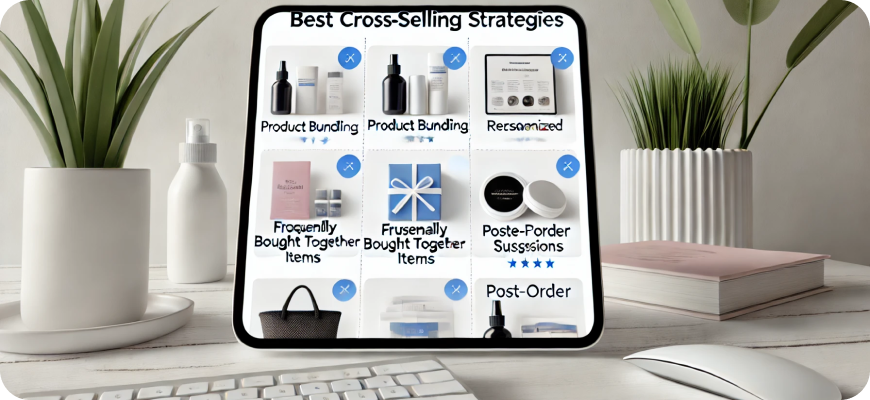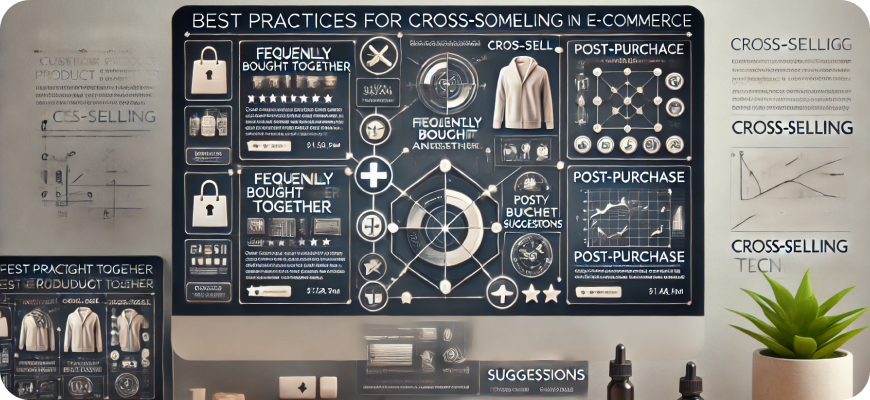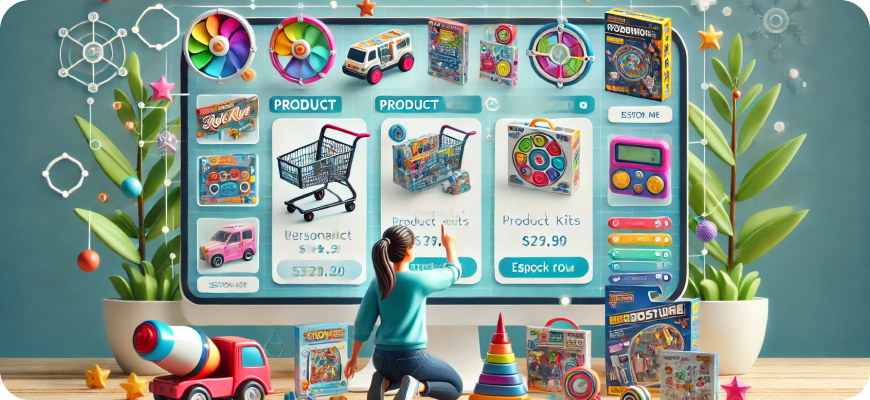What is Cross-Selling? Best Strategies and Best Practices
Cross-selling is a powerful strategy used by e-commerce businesses to increase average order value, improve customer experience, and enhance brand loyalty. It involves recommending additional products that complement the item a customer is purchasing, encouraging them to buy more items. Done right, cross-selling can drive significant revenue and deepen customer relationships, but it requires a thoughtful approach to avoid being perceived as pushy. This article covers what cross-selling is, the best strategies for implementing it, and best practices to optimize results.

What is Cross-Selling?
Cross-selling is the practice of offering customers related or complementary products to their current purchase. The goal is to enhance the shopping experience by helping customers discover products that add value to their primary purchase. Unlike upselling, which encourages customers to buy a more expensive version of the item they’re considering, cross-selling suggests additional items that go well with their selection.
Examples of Cross-Selling:
- Fashion Retail: When a customer buys a dress, they may be shown matching shoes, handbags, or accessories.
- Electronics: If a customer purchases a smartphone, they may be offered a phone case, screen protector, or headphones.
- Grocery: When purchasing pasta, customers might be recommended sauces, spices, or cheese to go along with their meal.
Cross-selling enhances the customer journey by helping them find products that complement their needs. When done effectively, cross-selling is seen as helpful rather than intrusive, leading to improved customer satisfaction and increased sales.
Benefits of Cross-Selling
Cross-selling provides numerous benefits to both businesses and customers:
- Increases Average Order Value (AOV): By encouraging customers to purchase related products, businesses can increase the total transaction amount without requiring additional customer acquisition efforts.
- Enhances Customer Experience: Cross-selling provides added value to customers by helping them find complementary products that enhance their purchase, leading to a more satisfying experience.
- Boosts Customer Loyalty: When cross-selling is done thoughtfully, customers are more likely to appreciate the recommendations, view the brand as helpful, and return for future purchases.
- Encourages Product Discovery: Cross-selling introduces customers to products they might not have discovered on their own, potentially increasing product visibility and expanding the customer’s perception of the brand.
Best Cross-Selling Strategies
Implementing cross-selling strategies effectively can be challenging, but the following techniques have proven to be successful across various industries.

1. Product Bundling
Product bundling is a common cross-selling strategy where complementary products are grouped together and sold as a package deal, often at a discount. This approach not only makes the customer feel like they’re getting more value but also encourages them to buy items they may not have initially considered.
Example: An electronics retailer might bundle a laptop with a mouse, keyboard, and laptop bag, offering a slight discount on the bundle compared to buying each item separately.
Benefits:
- Enhanced Value Perception: Customers feel they’re getting more value when items are bundled together, especially if a discount is involved.
- Increased AOV: Bundling typically leads to a higher transaction value as customers are more inclined to buy the package rather than individual items.
2. Frequently Bought Together
The “Frequently Bought Together” approach shows customers items that other buyers have purchased alongside the primary product. This method leverages social proof by highlighting items commonly bought together, which can encourage the customer to consider adding them to their cart.
Example: An e-commerce store selling cameras might display memory cards, camera bags, and tripods as frequently bought together items when a customer views a camera.
Benefits:
- Relevance: Frequently bought together items are highly relevant to the customer’s primary purchase, making it more likely they’ll find the suggestions useful.
- Easy Decision-Making: Customers can feel more confident in their choices, knowing that others have purchased similar combinations.
3. Post-Purchase Cross-Selling
Cross-selling doesn’t have to end at checkout. Post-purchase cross-selling involves recommending additional products after the initial transaction. This can be done via order confirmation pages, follow-up emails, or loyalty program suggestions.
Example: After a customer buys a coffee machine, an e-commerce store might send a follow-up email suggesting compatible coffee pods or descaling solutions to maintain the machine.
Benefits:
- Non-Intrusive Timing: Customers are more likely to consider additional purchases without feeling pressured when they’ve already completed a transaction.
- Improved Customer Retention: Post-purchase suggestions can bring customers back to your store and improve brand loyalty over time.
4. Personalized Recommendations
Personalization is a powerful tool in cross-selling, as it tailors recommendations based on individual preferences, past purchases, or browsing history. Customers are more likely to respond to suggestions that align with their tastes and shopping behavior.
Example: An online clothing retailer could use personalization to recommend similar items to previous purchases or suggest outfits that match the customer’s past purchases.
Benefits:
- Higher Relevance: Personalized suggestions increase the likelihood of conversion by aligning with the customer’s unique interests and needs.
- Enhanced Customer Experience: Personalized recommendations make the customer feel understood and valued, which can improve satisfaction.
5. Cross-Selling on the Product Page
Cross-selling on the product page is one of the most effective methods, as it reaches customers when they’re most engaged. Placing relevant suggestions near the “Add to Cart” button or below the product description can capture the customer’s attention and inspire them to explore complementary items.
Example: A bookstore’s product page for a novel could display related books by the same author or genre to encourage additional purchases.
Benefits:
- Convenient Access: Customers can easily add recommended items to their cart without navigating to different pages.
- Increased Engagement: By placing recommendations on the product page, customers are more likely to explore other products they may not have considered.
Best Practices for Effective Cross-Selling
To ensure your cross-selling efforts are successful and customer-friendly, follow these best practices.
1. Focus on Relevance
Relevance is key to successful cross-selling. Offering products that are closely related to the customer’s selection improves the likelihood of conversion and enhances the customer experience. Avoid suggesting products that seem random or unrelated, as this can create frustration.
Example: If a customer is buying a yoga mat, relevant cross-sell options might include yoga blocks, a water bottle, or workout clothes rather than completely unrelated products.
2. Avoid Overwhelming the Customer
Too many suggestions can overwhelm customers and lead to decision fatigue. Limit the number of cross-sell options to a few highly relevant items. Providing quality over quantity improves the customer’s overall experience and prevents them from abandoning their cart.
Best Practice: Limit cross-sell options to three or four items to keep the customer’s attention focused and avoid clutter.
3. Use Visual Cues to Highlight Cross-Sell Items
Visual cues such as “Complete the Look,” “You May Also Like,” or “Customers Also Bought” can make cross-sell items more appealing and guide the customer’s attention. Clear and intuitive placement increases the chances of engagement with suggested products.
Example: An online fashion retailer can use the “Complete the Look” prompt to suggest items like shoes and jewelry alongside a dress, giving the customer styling ideas.
4. Offer Discounts for Cross-Sold Items
Providing a small discount or bundle deal can be a great motivator for cross-selling. Customers are more likely to consider adding additional items to their purchase if they perceive extra value. This approach is especially effective with bundled items.
Example: Offer a “Buy More, Save More” deal where customers save 10% if they buy three or more items that complement each other.
5. Use Data to Optimize Cross-Selling Strategies
Analyzing customer data can provide insights into effective cross-sell combinations. By studying past purchases, buying patterns, and browsing behavior, you can refine your cross-sell suggestions and improve the relevance of your recommendations.
Best Practice: Use analytics tools to track cross-selling performance, assess customer preferences, and update cross-sell items regularly based on the latest trends and data.
6. Test and Optimize Cross-Selling Placement
Testing different cross-sell placements can help you find the optimal location for suggestions. Experiment with different placements, such as the product page, cart page, or post-purchase email, and measure the impact on conversion rates.
Best Practice: Use A/B testing to try different placements and layouts. Analyze which placements generate the highest engagement and adjust accordingly.
7. Educate Customers on the Benefits
When cross-selling, provide context for why the recommended products are useful. Briefly explain how the cross-sell items complement the main purchase to make the suggestions more compelling.
Example: If cross-selling a moisturizer alongside a facial cleanser, mention how using both products together can provide a more comprehensive skincare routine.
8. Make Cross-Selling Non-Intrusive
Cross-selling should feel like a helpful recommendation rather than an aggressive sales tactic. Use subtle prompts and avoid pop-ups that interrupt the customer’s journey. Keep suggestions easily accessible but unobtrusive to create a seamless shopping experience.
Best Practice: Place cross-sell items within the natural flow of the shopping journey, such as below the product description or as recommendations on the checkout page.
Common Pitfalls to Avoid in Cross-Selling
While cross-selling can be beneficial, there are common pitfalls to avoid:
- Suggesting Irrelevant Products: Irrelevant recommendations can frustrate customers and negatively impact their shopping experience. Stick to items that are genuinely complementary.
- Overloading the Customer with Options: Too many cross-sell suggestions can lead to decision fatigue. Focus on a few high-quality recommendations instead of overwhelming the customer with choices.
- Using Aggressive Tactics: Avoid pushy pop-ups or intrusive notifications. Cross-selling should feel like helpful advice rather than a hard sell.
- Neglecting Data: Relying on assumptions rather than data can lead to ineffective cross-sell suggestions. Use analytics to guide your strategy.

Conclusion
Cross-selling is a powerful strategy that, when executed thoughtfully, can enhance the customer experience, increase average order value, and improve brand loyalty. By employing strategies like product bundling, personalized recommendations, and post-purchase cross-selling, e-commerce businesses can maximize the value of each transaction while providing added benefits to their customers. Remember to prioritize relevance, avoid overwhelming your customers, and make data-driven decisions to optimize your cross-selling approach. With the right strategies and best practices, cross-selling can be a win-win for both your business and your customers.






